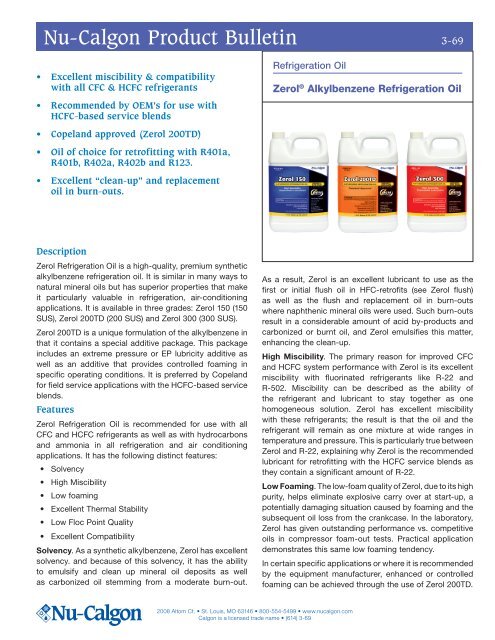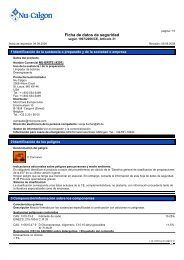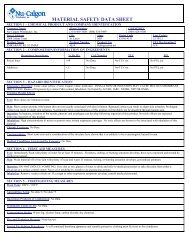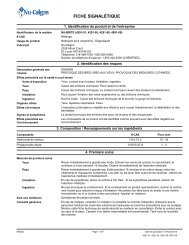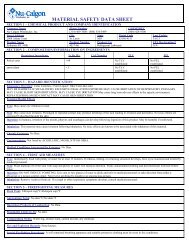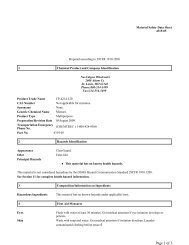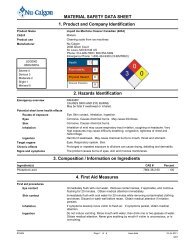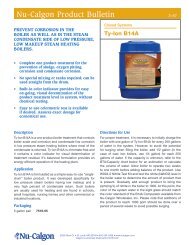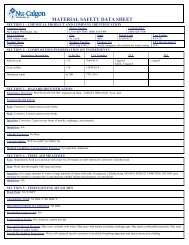Zerol Alkylbenzene Refrigeration Oils - Nu-Calgon
Zerol Alkylbenzene Refrigeration Oils - Nu-Calgon
Zerol Alkylbenzene Refrigeration Oils - Nu-Calgon
You also want an ePaper? Increase the reach of your titles
YUMPU automatically turns print PDFs into web optimized ePapers that Google loves.
<strong>Nu</strong>-<strong>Calgon</strong> Product Bulletin 3-69• Excellent miscibility & compatibilitywith all CFC & HCFC refrigerants• Recommended by OEM’s for use withHCFC-based service blends<strong>Refrigeration</strong> Oil<strong>Zerol</strong> ® <strong>Alkylbenzene</strong> <strong>Refrigeration</strong> Oil• Copeland approved (<strong>Zerol</strong> 200TD)• Oil of choice for retrofitting with R401a,R401b, R402a, R402b and R123.• Excellent “clean-up” and replacementoil in burn-outs.Description<strong>Zerol</strong> <strong>Refrigeration</strong> Oil is a high-quality, premium syntheticalkylbenzene refrigeration oil. It is similar in many ways tonatural mineral oils but has superior properties that makeit particularly valuable in refrigeration, air-conditioningapplications. It is available in three grades: <strong>Zerol</strong> 150 (150SUS), <strong>Zerol</strong> 200TD (200 SUS) and <strong>Zerol</strong> 300 (300 SUS).<strong>Zerol</strong> 200TD is a unique formulation of the alkylbenzene inthat it contains a special additive package. This packageincludes an extreme pressure or EP lubricity additive aswell as an additive that provides controlled foaming inspecific operating conditions. It is preferred by Copelandfor field service applications with the HCFC-based serviceblends.Features<strong>Zerol</strong> <strong>Refrigeration</strong> Oil is recommended for use with allCFC and HCFC refrigerants as well as with hydrocarbonsand ammonia in all refrigeration and air conditioningapplications. It has the following distinct features:• Solvency• High Miscibility• Low foaming• Excellent Thermal Stability• Low Floc Point Quality• Excellent CompatibilitySolvency. As a synthetic alkylbenzene, <strong>Zerol</strong> has excellentsolvency. and because of this solvency, it has the abilityto emulsify and clean up mineral oil deposits as wellas carbonized oil stemming from a moderate burn-out.As a result, <strong>Zerol</strong> is an excellent lubricant to use as thefirst or initial flush oil in HFC-retrofits (see <strong>Zerol</strong> flush)as well as the flush and replacement oil in burn-outswhere naphthenic mineral oils were used. Such burn-outsresult in a considerable amount of acid by-products andcarbonized or burnt oil, and <strong>Zerol</strong> emulsifies this matter,enhancing the clean-up.High Miscibility. The primary reason for improved CFCand HCFC system performance with <strong>Zerol</strong> is its excellentmiscibility with fluorinated refrigerants like R-22 andR-502. Miscibility can be described as the ability ofthe refrigerant and lubricant to stay together as onehomogeneous solution. <strong>Zerol</strong> has excellent miscibilitywith these refrigerants; the result is that the oil and therefrigerant will remain as one mixture at wide ranges intemperature and pressure. This is particularly true between<strong>Zerol</strong> and R-22, explaining why <strong>Zerol</strong> is the recommendedlubricant for retrofitting with the HCFC service blends asthey contain a significant amount of R-22.Low Foaming. The low-foam quality of <strong>Zerol</strong>, due to its highpurity, helps eliminate explosive carry over at start-up, apotentially damaging situation caused by foaming and thesubsequent oil loss from the crankcase. In the laboratory,<strong>Zerol</strong> has given outstanding performance vs. competitiveoils in compressor foam-out tests. Practical applicationdemonstrates this same low foaming tendency.In certain specific applications or where it is recommendedby the equipment manufacturer, enhanced or controlledfoaming can be achieved through the use of <strong>Zerol</strong> 200TD.2008 Altom Ct. • St. Louis, MO 63146 • 800-554-5499 • www.nucalgon.com<strong>Calgon</strong> is a licensed trade name • (614) 3-69
Excellent Thermal Stability. <strong>Zerol</strong> enhances the life ofrefrigeration systems by providing better thermal stabilityin the presence of refrigerants. Laboratory tests andfield experience show that <strong>Zerol</strong> resists change underhigh temperatures, thus eliminating problems with sludge,acids, and copper plating. A good indicator of a lubricant’sstability is the sealed tube or Elsey test.Low Floc Quality. Because it is synthetic and is highlypure, it contains no paraffin or wax, a substance in mineraloil that normally causes floccing or the formation of waxydeposits that can plug up a system. Strict quality controlsfrom manufacturing through shipping ensure that <strong>Zerol</strong>maintains its high purity, allowing better efficiency at lowtemperatures, well below -100ºF.Excellent Compatibility. Converting refrigeration andair conditioning systems to <strong>Zerol</strong> is easily achieved dueto its excellent compatibility. <strong>Zerol</strong> can be blended withconventional oils, is inert toward motor insulation, has ULapproval for use in hermetic systems, and is compatiblewith most elastomers and additives often used to improvelubricity such as tricresyl phosphate (TCP).PackagingAll <strong>Zerol</strong> formulations are packaged in 1 gallon bottles (6per case) and 55 gallon drums. Note that 5 gallon pails areavailable upon special request.HandlingContamination problems are extremely critical in refiningand handling refrigeration oils. Great care is used to insurethat <strong>Zerol</strong> <strong>Refrigeration</strong> Oil is free of moisture and noncondensablessuch as air. The same degree of care mustbe used by the service professional to make certain that theoil remains clean and dry.Here are some rules for handling refrigeration oil:1. Use clean tools – Pumps, funnels, tubing, etc. – whileworking with the oil.2. Recap the bottle immediately after use. <strong>Refrigeration</strong> oilin an open bottle will absorb moisture.3. Keep refrigeration oil in its original container. If youmust pour oil into another container, be sure that thecontainer is clean and dry.4. Properly dispose of oil that you think dirt or moisturehas contaminated. Don’t risk using it. It is much lessexpensive to replace a bottle or refrigeration oil than torepair or replace a compressor.PRODUCT SPECIFICATIONSPRODUCT CODE NUMBERS
ApplicationsBecause of its unique solvency and miscibility properties,<strong>Zerol</strong> is particularly useful in several specific applications.In burnouts, the solvency of <strong>Zerol</strong> enables it to be used toclean up the by-products and burnt oil while its exceptionalmiscibility with R-22 and R-502 makes it the oil of choicewith these two refrigerants, especially R-22 low tempapplications. And this exceptional miscibility with R-22 isalso why <strong>Zerol</strong> is recommended for use in retrofitting withthe HCFC service blends as they are based on R-22.Recommended for Burn-outsIn systems utilizing mineral oils where a moderate burn-outhas occurred, <strong>Zerol</strong> can be used to flush and clean up thesystem. <strong>Zerol</strong> will emulsify the acid by-products, burnt oiland wax that result from such burn-outs, and allow thesystem to be flushed clean.Use the following general procedure:1. Remove burned-out compressor and disconnectelectrical leads.2. Remove expansion valve (or cap tube) and installby-passes.3. Replace suction and liquid line filter driers.4. Use connections where burned compressor waslocated, and push <strong>Zerol</strong> 150 through the system with apositive displacement pump. Use a volume of <strong>Zerol</strong> 150equal to three times the amount (weight) of refrigeranttypically charged into the system. Although the systemmay possibly operate on <strong>Zerol</strong> 150, <strong>Zerol</strong> 300 or <strong>Zerol</strong>200TD, we recommend the use of 150 for the flushingas it is a lighter cut oil and will therefore perform thetask more effectively.5. Circulate for 2-4 hours, change filters often. Thenremove <strong>Zerol</strong> cleaning solution from system.6. Blow nitrogen through system.7. Install new compressor as well as other removedcomponents and triple evacuate the system; conductleak check.8. Operate the system with fresh refrigerant and <strong>Zerol</strong> ofthe proper viscosity (150, 200TD or 300).9. Check system. If oil discolors, replace oil and filterdriers.Recommended for Existing R-22 & R-502 SystemsIf refrigerants and their oils are not fully miscible at alloperating temperatures and pressures, as is the case withmineral oil and R-22 & R-502, they can separate into liquidlayers. This results in poor oil return as well as poor heattransfer as the oil logs in the evaporator, an area with thesystem’s lowest temperature. In turn, the poor oil return canresult in subsequent lubricity problems.In addition, refrigerant migration to the compressor duringshut down can result in the formation of two layers, with thelighter mineral oil layer on top; this is particularly true withR-502 and mineral oil. At start-up, the heavier refrigerantrichlayer will be lubricating some moving parts, and that isnot a good idea. In flooded evaporators, where an oil-richlayer forms on top of the refrigerant, all these problems aremagnified.Of particular concern is the use of mineral oil and R-22in low temperature applications. At the lower operatingtemperatures in the evaporator, the immiscibility betweenthe R-22 and the mineral oil can become a significantproblem. As you can see in Figure I, even the bestnaphthenic mineral oil will separate out at about 30ºF,where the oil/refrigerant ratio is approximately 20%/80%.<strong>Zerol</strong> 150, however, will not form two phases until -105ºF atthe same 20%/80% oil/refrigerant ratio. Similar disparitiesbetween these oils when used with R-502 can be seen inthe second chart.Figure IRecommended for Retrofitting with HCFC Service BlendsBecause of its exceptional history in working with R-22,due primarily to its excellent miscibility with this refrigerant,<strong>Zerol</strong> has been identified by compressor and equipmentmanufacturers as the oil of choice in retrofitting to theinterim HCFC-based service blends such as:R-401a R-402a R-408aR-401b R-402b R-409aThe reason for this is simple: these interim refrigerantsare blends, and R-22 is a significant component in eachof them. It is understood that good refrigerant/lubricantmiscibility is one of the performance characteristics thatmust be maintained as a system is retrofitted from R-12or R-502 to one of these blends, and the use of <strong>Zerol</strong>accomplishes this performance level.
Use with HCFC blends… ContinuedWithin the last several years, thousands of systems havebeen retrofitted with <strong>Zerol</strong> and the HCFC interim blends.Here is a simplified version of the procedure:1. Establish and obtain all data pertinent to the systemsoperation.2. Evacuate the CFC refrigerant, and recover itappropriately.3. Remove the mineral oil. In systems with small hermeticcompressors, use the <strong>Nu</strong>-<strong>Calgon</strong> CanVerter® or similarpump, or drain from the suction line. Utmost care mustbe exercised to insure that all or nearly all of the mineraloil is removed, particularly in larger systems wherecomponents like separators are in use.4. If compressor was removed in the oil draining process,reinstall it.5. Measure the volume of mineral oil removed andcompare with the systems specification fill to judgehow much has been removed. Replace it with a likevolume of <strong>Zerol</strong> of the proper viscosity (ie. Copelandrecommends <strong>Zerol</strong> 200TD).6. Replace filter drier. Typically for loose filled driers,the XH-9 molecular sieve desiccant or equivalent isrecommended. Compacted bead driers may use theXH-9 or XH-6 desiccant or equivalent.7. Reconnect system and evacuate. Check for leaks.8. Charge system with appropriate amount of the HCFCservice blend refrigerant.9. Mark system as to refrigerant and lubricant in use.Make appropriate system adjustments.10. Observe operation. <strong>Zerol</strong> will tend to clean up oldmineral oil deposits, and this matter will be trappedby the drier. Change driers as needed. If the oilloads up with carbon deposits and other matter, thisindicates that the system had experienced rathersevere depositing of mineral oil over time, and the <strong>Zerol</strong>should be replaced.<strong>Zerol</strong> Flush. As the sir conditioning, refrigeration industrycontinues to move to the increased use of long-term HFCrefrigerants, it will be necessary to utilize polyol esteror POE lubricants. These lubricants have been found toprovide long term performance advantages with HFCrefrigerants. And as existing equipment or systems in thefield are retrofitted to these new HFC refrigerants, it willactually be necessary to drain (flush) the system 3-5 timeswith polyol ester in order to reduce the residual level of thepreviously used mineral oil to 5% or less. The concern hereis once again miscibility as the HFC and mineral oil are notmiscible together.This POE flushing procedure has been successfullyaccomplished thousands of times in the field. The resultsare predictable, and the mineral oil residual is effectivelyreduced to the desired level. Perhaps the only drawbackto the procedure is that 2-4 flushes of comparatively moreexpensive POE oil must be used and discarded.An attractive and proven alternative is the <strong>Zerol</strong> Flush,a procedure that involves the use of <strong>Zerol</strong> alkylbenzenelubricant in place of the polyol ester lubricant for the first 1or 2 oil flushes, followed by 1 or 2 POE flushes. Because<strong>Zerol</strong>’s solvency is similar to the POE, it does an equallyeffective job of emulsifying mineral oil and cleaning upexisting mineral oil deposits. More importantly, it providesfor two distinct cost savings:First, because <strong>Zerol</strong> is generally one-third the cost ofthe POE, using it in the first 1 or 2 flushes will result inimmediate savings. It also provides the added benefit ofbeing easier to handle since it is not susceptible to moisturecontamination like POE’s are. This, too, will save money bysaving time.Secondly, because it has been shown that HFC/POEsystems can tolerate twice as much residual alkylbenzeneas residual mineral oil (see Figure II), it may be possible toeliminate one of the subsequent POE flushes if the systemis initially flushed with <strong>Zerol</strong>.Figure II: The effect on HFC/POE miscibility of residualmineral oil (5%) vs. residual <strong>Zerol</strong> (10%)Temperature35ºF4ºF-40ºF5% MO/95% POEHomogeneousMixtureCloudy, withOil-Rich LayerMore Cloudy, OilLayer Near Solid5% <strong>Zerol</strong>/95% POEHomogeneousMixtureCloudy, Homog.MixtureMore Cloudy,Oil Rich LayerTests were conducted with HFC-404a at a ratio of 20% Lubricant and 80% RefrigerantAs you can see in Figure II, we have mixed two equalsamples of R-404a with lubricant mixtures, one being5%/95% Mineral/POE and the other 10%/90% <strong>Zerol</strong>/POE.At 35ºF, both lubricant mixture/refrigerant samples exhibitgood miscibility by remaining as homogeneous mixtures.However, at 4ºF the sample with 5% mineral oil has turnedcloudy and formed an oil-rich layer while the samplewith 10% <strong>Zerol</strong> has only turned cloudy but exhibited nomiscibility problems. At -40ºF, the oil layer in the 5% mineraloil sample has turned solid while the 10% <strong>Zerol</strong> sample isonly beginning to form an oil rich layer. Simply stated, thisshows that twice the residual of <strong>Zerol</strong> exhibits even lessmiscibility problems than residual mineral oil.Here is how to use the <strong>Zerol</strong> Flush in converting from a CFCto the long term HFC refrigerant:1. Obtain pertinent system operational data.2. Drain existing oil and replace with an equal volume of<strong>Zerol</strong> of the proper viscosity.3. Operate system for at least 48 hours with CFC in it.4. Drain lubricant and either repeat steps 2 and 3 onemore time, or replace with an equal volume of POE.5. Repeat steps 3 and 4 using POE until mineral oilresidual is below 5% when tested. Use the <strong>Nu</strong>mber4815-0 Refractometer for testing.6. Charge with new HFC refrigerant and label the system.7. Be sure to change filter driers at appropriate timesduring the process.2008 Altom Ct. • St. Louis, MO 63146 • 800-554-5499 • www.nucalgon.com<strong>Calgon</strong> is a licensed trade name • (614) 3-69


